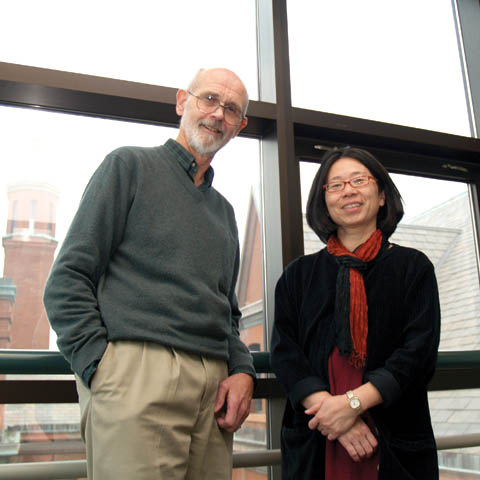| |
|
|

from the issue of November 9, 2006
|

| |
|
|
| |
Lunch-hour discussion spurs new course, online database

Profs meld architecture, humanities

BY TROY FEDDERSON, UNIVERSITY COMMUNICATIONS
Sir Isaac Newton had his apple. Ben Franklin had a lightning bolt. James Potter and Rumiko Handa had lunch.

| | 
 
| | | DATABASE CREATORS - Architecture professors James Potter and Rumiko Handa have created a course and online database linking elements of architecture with the humanities. Photo by Troy Fedderson/University Communications.

|
Powered by a discussion held over bagels, the UNL professors of architecture created a course offering and an Internet database, both dedicated to linking architecture to film, literature, art and theater.

"We started talking and thought it would be interesting to have a class and a database that sort of brought architecture together with the humanities," Potter said. "The idea came from a combination of our professional interests in architecture and the fact that we just like films. We thought it might be good thing to pursue."

The course - a professional elective currently listed as 497, Selective Topics in Architecture - was first offered in 2001. Designed to be interactive, with students and professors working together to forge links between the disciplines, the class failed to take off as expected.

"It was much more lecture than I wanted it to be," Potter said. "So, we let it lay dormant for a year. We revised it and gave it a broader perspective."

Students in the course study the types of architecture and how it is used in a specific humanity element. The information is incorporated into the "Architecture in Humanities" database, available for review at http://libtextcenter.unl.edu/aith.

Student research areas this semester include the film "The Canterbury Tales" and novels by Jane Austen.

"In principle, the information included on the database is the same you will find in college level textbooks," Handa said. "But, not all of the works in textbooks have good associations with disciplines outside architecture. So, we are working to create those connections."

The Web component started to take shape in summer 2004. The site has been built on research from students in the course, nine UCARE student workers (including six currently working on the project) and three graduate research assistants. Handa said the site includes more than 600 listings.

Each listing includes a variety of images related to the particular piece of architecture. Also, the listing includes information about how the structure has been presented in literature, film, theater and art. Along with architectural drawings and photos, the site incorporates film clips, art images, related literature and additional Internet links.

"We knew this was going to be a enormous job," Handa said. "But, we felt it would be an important database that could present research opportunities across disciplines."

Overall, Potter and Handa said the project has been well received.

"We've talked with people in Modern Languages, history, literature, art and art history and they all think it is an interesting concept," Potter said. "It really has sparked some ideas between the disciplines. There really is something to this idea."

Funds for the project have been provided by the Graham Foundation, the Arts and Humanities Enhancement Fund and a Teaching and Learning Seed Grant. In addition, Potter and Handa have applied for a National Endowment for the Humanities grant.

 
| | Henri Matisse's "Notre Dame in the Late Afternoon" oil painting.

| |
"We applied to the NEH a year ago and received a favorable response, but we didn't receive funding," Potter said.

The rewrite provides a narrower focus on British buildings in 19th century historical novels, plays and paintings.

The database and course concepts have been presented at national and international conferences. Handa said a number of conference attendees have expressed an interest in helping with the project.

"Setting up a structure for contributions is the next step," said Potter. "A lot of scholars out there do fantastic stuff in this area, and getting input from them would be fantastic."

For now, Potter and Handa are seeking input from faculty, staff and students at UNL.

"The database remains a work in progress, but we are excited by how far it's come," Potter said. "We want to let campus know that this resource is available to them, and we welcome feedback from anyone."

Contact Potter at jpotter2@unl.edu or 472-9240. Handa can be reached at rhanda1@unl.edu or 472-0240.
GO TO: ISSUE OF NOVEMBER 9
NEWS HEADLINES FOR NOVEMBER 9
Profs meld architecture, humanities
Oakley guides UNL's first Asian American lit class
Sheldon seminar aims to integrate art, coursework
'Ethanol's Lost History' presented Nov. 16
Labor force grows despite population declines
National honors council finds home at UNL
Students volunteer for ABC
732624S36403X
|
|
|
|
|
|
|
|